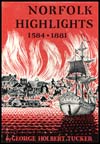Chapter 6
The "Half Moone" Fort
There was a fort on the site of downtown Norfolk seven years before the establishment of the town in 1680. The fort was an outgrowth of the war between England and the Netherlands, during which the latter lost its colonial possessions on the North American continent.
Three years after the British took possession of New Amsterdam in 1664 and renamed it New York, a retaliating Dutch fleet swooped down on a fully loaded tobacco fleet of twenty vessels anchored at the mouth of the James River. After disabling the Elizabeth, a leaky old forty-six gun frigate detailed to defend the convoy, the Dutch captured all of the defenseless merchantmen, burned five or six of them, and made off with the others.
Six years later a similar Dutch fleet wreaked havoc on another tobacco fleet anchored in Lynnhaven Bay. Alarmed by such daring actions on its doorstep, the Virginia Assembly bestirred itself to pass laws to provide for the protection of its people and commerce.
An act of 1667 had already authorized the construction of five forts on the James, Nansemond, York, Rappahannock, and Potomac rivers. And after the 1673 attack another act was passed to build two additional forts, one in Isle of Wight County, the other in Lower Norfolk County.
The act provided that the forts be erected at the expense of the county to be defended. And after the freemen of Lower Norfolk County, which then included the area now occupied by Norfolk, Chesapeake, Portsmouth, and Virginia Beach, had agreed to foot the bill, the justices of the county went ahead with the building plans.
The old court record reads: "It is therefore by them Ordered that it be built upon foure farthing point, being a point of land belonging to the orphants of Nicholas Wise, decd., and that the modell be in the form of a half moone."
In order to cut down on expenses, the justices ordered that every tithable in the county give two days of free labor on the project or "hier others in their Roome."
A Lower Norfolk County citizen named Paul Trige was also appointed "overseer of the work" on which every worker furnished his own tools and food. To put a bite into the law, the justices also decreed that anyone who refused to bear his share of the work was to be fined twenty-five pounds of tobacco for each day he failed to show up on the job.
Four Farthing Point, on which the fort was built, was at the extreme western end of Main Street directly opposite the present Portsmouth Naval Hospital. It was also the same site that was later known as Town Point. The ordnance of the fort consisted of demi-cannon and whole culverns "because our rivers are so wide."
Apparently the fort, which cost the citizens of Lower Norfolk County thirty-five thousand pounds of tobacco to erect, had been completed by October 7, 1680, when John Ferebee, the Lower Norfolk County surveyor, began laying out the nucleus of the present Norfolk.
All traces of the early fort, which antedated the port of Norfolk by seven years, have disappeared. But as late at 1781, when the British occupied the Norfolk and Portsmouth area during the Revolutionary War, professional soldiers of Great Britain erected another temporary fort on the same site to protect the inner Norfolk harbor.
Chapter 7
The Birth of "Norfolk Towne"
Norfolk Highlights 1584 - 1881

See the "Table of Contents" for links to every chapter in Norfolk Highlights 1584 - 1881 by George Holbert Tucker.
